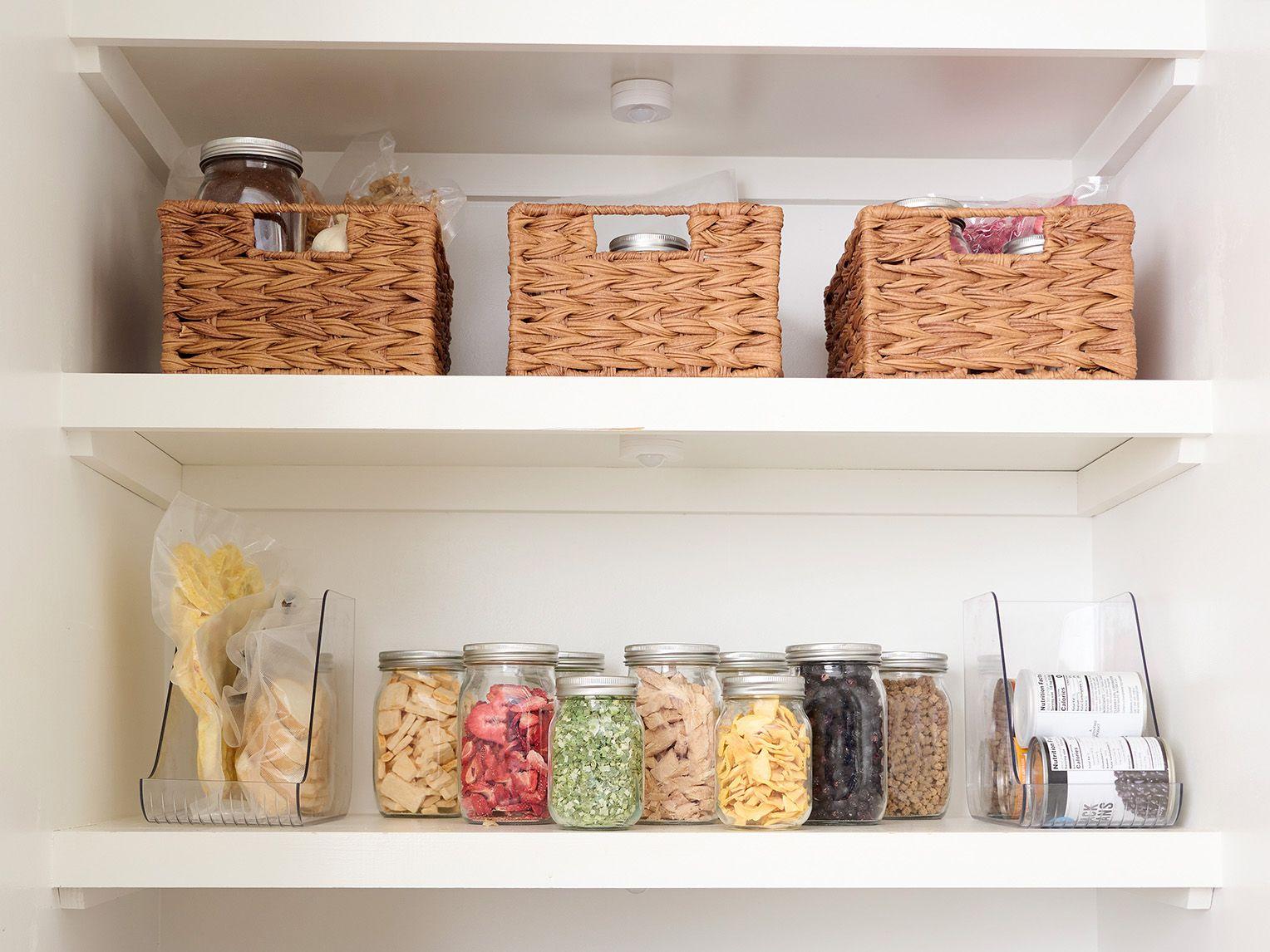Learning Basic - and Unusual - Food Storage Methods

In theory, a four-week supply of survival food could be more valuable than a one-year supply.
How is that possible? Because of the way the food is stored. If the one-year food supply is not protected from extreme temperatures, light, air and moisture, it could go bad well before it’s needed.
But if the one-month supply is fully protected from those enemies of food preservation, it could stay good for many years.
Now, don’t get me wrong. More is almost always better than less when it comes to stockpiling survival food. But the manner in which that survival food is stored is vital.
A variety of methods
Today I want to provide you with some food storage basics. As well as some unusual methods you may not have considered. Then I’ll finish with the best possible method of food storage.


Each has its good points. But they also have their downsides, including the amount of time and energy you will need to put into the process.
Some people enjoy spending their time in these activities. If you’re one of them, you can relate.
Drying and canning
Grains and beans can be purchased already dried. They can also take up a lot of space in your home.
If you keep them elsewhere, you’ll spend time going back and forth to keep an eye on them because dampness could quickly ruin your supply.
With a food dehydrator, you can dry a variety of food yourself. Then make sure that it is stored in airtight containers.
The canning process involves sealing your cooked food while it’s hot in order to kill bacteria that might spoil it. Keep it at room temperature and away from sunlight.
Entire books have been written about canning, and you can also find plenty of information online. If done properly, this is an effective way to preserve food.
Pickling, brining and salting
Preserving food with vinegar, salt and spices is the strategy behind pickling, brining and salting.
Pickling is the technique that uses the combination of salt and vinegar to preserve vegetables, fruits and meats. It has been used since ancient times.
Brine is a solution consisting of cold water, salt and sugar. Mainly used for meat and poultry, brining is similar to marinating. Food is soaked in brine for six to 12 hours to prevent microbiological growth.
Salting is also a very old technique. The salt draws moisture from the meat, preventing bacterial growth.
Smoking and fermenting
The smoking method was formerly used only for meat and fish. But today people also use the technique for smoking vegetables.
Burning materials such as wood provide strong heat. And that heat kills bacteria and other food microorganisms.
The food is heated above an open fire. For meat, that means between about 40 to 160 degrees Fahrenheit, depending on the type and cut. Vacuum sealers are able to preserve a wide variety of smoked foods for an extended period of time.
Fermentation, which preserves key nutrients in food, was discovered thousands of years ago. Probably by accident. In a nutshell, it’s controlled decay. Carbohydrates are converted into alcohol or acids using good bacteria.
You can ferment just about any food. Kombucha is a fermented food that contains probiotics, which are bacteria that aid in digestion. Sauerkraut is another example of a fermented food.
Root cellars
Some folks use root cellars to store fresh produce. They keep food at a cool temperature with the proper amount of humidity.
It’s similar to burying food to keep it fresh, as our ancestors did.
Don’t wash dirt off after harvesting your produce. And you’ll want to keep space between your produce on shelves.
Among the produce you can store in a root cellar are apples, beets, cabbage, carrots, garlic and leeks.
As well as onions, pears, potatoes, pumpkins, squash, tomatoes and turnips.
5 food storage tips and tricks
Here are a few lesser known tips and tricks for storing your food.
- Before you store flour, keep it in the freezer for a few days. That will kill off any weevil eggs that might be present. Otherwise they could hatch while your flour is sitting on a shelf.
- Toss oxygen absorbers in your food bags. Use a 300cc absorber for a one-gallon bag and a 2,000cc absorber for a five-gallon bag. Keep unused absorbers in an airtight jar.
- Include bay leaves in your bags of beans, rice and flour. Ants and other pests hate the smell of those leaves.
- Unopened butter will last longer in a freezer (12 months) than in a refrigerator (4 months). But mayonnaise will stay fresher in the “warmer” part of a fridge (the door) than in the colder, inner part.
- If you’re freezing strawberries, blueberries or raspberries, first wash them in a 10-to-1 ratio of water to vinegar, then dry them. That should keep them fresher twice as long and keep pests at bay.
11 food storage errors to avoid
Some people like to select and build their own survival food stash. Others prefer to purchase a one-and-done solution.
If you’re a do-it-yourselfer in this area, following are a few mistakes you’ll want to avoid:
- Ignoring the importance of nutrition. Sometimes people are so concerned about the volume of food they store that they forget about vitamin and mineral content.
- Using sacks or other containers that are not airtight. The elements will decrease the shelf life of stored food. And containers that are not airtight increase the odds of insects or a critter accessing it.
- Failing to keep food containers in a cool, dry place. Heat and moisture are two of the chief enemies of food.
- Failing to keep food containers in a dark place. Light can deplete the vitamin content of food.
- Storing too many items that need refrigeration. It’s likely that a crisis will include a potentially lengthy power outage. Refrigerated items will spoil quickly.
- Failing to include enough of a variety of different foods. Eating the same foods for the first couple days of a crisis may be all right. But everyone will want something different very soon.
- Failing to maintain a good balance in the stored foods. Make sure your stored items provide a variety of different vitamins and minerals.
- Failing to include at least a small percentage of “comfort foods.” These types of foods can be a huge psychological lift during an emergency.
- Failing to check expiration dates and rotate stored food. Organize your food containers by expiration dates. When a date if approaching, either consume that food or donate it to a shelter, then replace it with newer food.
- Storing all of your food in one location. If you do this you’re putting all of your eggs in one basket. If your home is destroyed during a disaster, you’ll be glad you kept some food and water in a secondary location.
- Announcing to the neighborhood that you stockpile food. If a disaster strikes and your neighbors know you have survival food stockpiled, they may not act so neighborly. Keep this information within your family. You can always share food later if you choose to, but you don’t want it taken away.
The best method? Freeze-drying!
As promised, here is the best possible way to store survival food. It’s freeze-drying the food and packaging it in Mylar bags.
Freeze-drying is a complicated process involving the freezing of food in a vacuum chamber. The food’s moisture then evaporates from its solid state to a gaseous state. The taste and structure of the food is preserved, but the moisture content is removed.
Freeze-drying allows food to retain more nutritional value than other processes, such as canning and drying. Freeze-dried food also retains its shape and taste after it’s been reconstituted with water.
That’s how we produce and protect our survival food at 4Patriots. The result is that when properly stored, it’s good for up to 25 years.
And almost as important as having nutritious food waiting for you when you need it is the peace of mind you’ll enjoy in the meantime.
References:
- All testimonials in this advertisement are from real people; sometimes names and photos have been changed to protect their privacy and some were given free products in exchange for their honest feedback. Testimonials represent exceptional results, don't apply to the average purchaser and are not intended to guarantee that anyone will achieve the same results. The organizations, publications and people referenced on this site are not affiliated with 4Patriots. They have not endorsed, sponsored or recommended this product; no affiliation or endorsement is claimed. Terms & conditions apply. Cade Courtley is a former Navy SEAL and Platoon Commander who served 9 years of active duty and has been compensated by 4Patriots for his hard work in helping us test and endorse this product. Cade Courtley is a former Navy SEAL who served 9 years of active duty and has been compensated by 4Patriots for his hard work in helping us test and endorse products.
- U.S. Consumer Product Safety Commission. CPSC Releases New Report on Carbon Monoxide (CO) Fatalities, Urges Generator Safety in New PSA. August 2022.
- Peak output for the Patriot Power Generator increased from 3,048 W (1800 model) to 4,000 W (2000X model). Continuous output is 1,800 W and 2,000 W, respectively. Storage capacity for DC devices increased from 768 Wh (1800 model) to 1536 Wh (2000 model).
- Refrigerators, freezers and similar appliances maintain a safe temperature by running on cycles. The CDC recommendation is to keep temperature below 40°F and above 32°F. If starting with a cold appliance, running backup power to your fridge for 1 hour will maintain temperature for about 4 hours. Usage conditions will impact this estimate (interior temp, exterior temp, appliance age & features, fridge contents, etc.). Click here for more tips on cycling your fridge or freezer.

